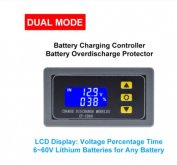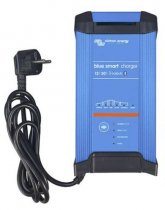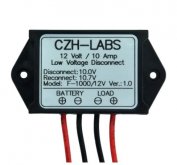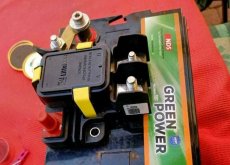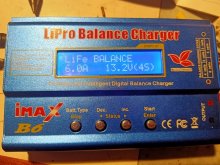Sorry all, been away for a bit ... I'm in the middle of website refresh, which is taking up a lot of my time. I'm still keen to do this but might be a few more days before I can dedicate the time to do the analysis. Good to see lots of constructive comments on the topic.
You are using an out of date browser. It may not display this or other websites correctly.
You should upgrade or use an alternative browser.
You should upgrade or use an alternative browser.
What's The Best BMS? (Grrrr... ?)
- Thread starter tictag
- Start date
Series pass disconnect is the two back to back power MOSFET's in many BMS's to disconnect the battery from inverter/charger. It is bi-directional which is why there is two back to back MOSFET to handle charge current and discharge current directions. The lower their series resistance the better to avoid BMS heating under higher current loads. Their only purpose is for safety to open the connection path to the battery. Normally they are always 'ON'. If they create too much heat and fail shorted they can create more of a safety issue then they are there to protecting against.
Congratulation, it only took 85 posts to get to what helps define a good BMS. I find it grossly lacking when a BMS spec does not include the pass through resistance. That is a major omission.
If system current is more than 100A then a fet based BMS is not a good choice. Most likely in this case an inverter is involved. Choose a BMS with external disconnect controls. There are low current disconnect options that don’t include high current FETs or power consuming relays. Design a smart system, not one that uses brute force.
I would like to know the pass through resistance of the listed fet based BMS. Place voltmeter from battery + to BMS + output under a known current. Calculate resistance: R = V/I
Do same for the negative side of circuit.
Congratulation, it only took 85 posts to get to what helps define a good BMS.
85 posts aint nuthin.
Check out the 1,253 posts on XUBA 280 ah cells ?
85 posts aint nuthin.
Check out the 1,253 posts on XUBA 280 ah cells ?
And then consider that the second most replied to post behind the Xuba thread with 1253 posts, is another Xuba thread with 881 Posts, and then a third post on the same cells sold by Dongguan Billion has nearly 200 posts!
Those three posts on the 280Ah cells have racked up 100,000 views combined.
And to think 5ish months ago nobody here had even heard of those cells. Now posts on 280Ah cells probably account for at least half the traffic and engagement on the site!
Those three posts on the 280Ah cells have racked up 100,000 views combined.
To be fair, I probably account for 10,000 of those views. ?
HKZBob
New Member
- Joined
- Nov 7, 2020
- Messages
- 52
Why BMS,
I think we all get blind when we hear the term "Management". What a strong marketing gimic.
The best BMS is to use none!!!
Why the lifetime of power electronics is limited and the severity that your BMS dies is much higher than your Lifepo4.
A smart reliable Lifepo charger with a display and high current fuse for short circuit protection. Ce tout, that is it, mehr nicht.
A Megafuse is the best reliable choice for a overcurrent protection / short circuit
Think about it, I will not use a Battery Mistake System. And when I am dead, my Lifepo´s will still work, yours not.
Bye Bye Amercia, sleep well.
??
I think we all get blind when we hear the term "Management". What a strong marketing gimic.
The best BMS is to use none!!!
Why the lifetime of power electronics is limited and the severity that your BMS dies is much higher than your Lifepo4.
A smart reliable Lifepo charger with a display and high current fuse for short circuit protection. Ce tout, that is it, mehr nicht.
A Megafuse is the best reliable choice for a overcurrent protection / short circuit
- Littelfuse 880195400 hpdm
- An balancer active or passive is good enough. A watchdog (buzzer) for low voltage alert.
- If you compare the severity of an short circuit case that is not detected by a fuse compared to am BMS short circuit Mosfet failure than I know what to pick.
- Low Voltage protection. How high is the severity to run into low voltage condition. On an 4S you can use a buzzer (10V) but it will never buzz. Because your smart charger will not allow this.
- By the way a smart charger will not allow to run in overvoltage a well. ( but for this you can use a monitor buzzer as well)
- And take a look below Battery Charging Controller 8$ piece of mind can give you an over & under voltage alert. ( Put a buzzer or relay with a taser behind)
Think about it, I will not use a Battery Mistake System. And when I am dead, my Lifepo´s will still work, yours not.
Bye Bye Amercia, sleep well.
??
Attachments
A fair question to ask but you should stop at the question, your assumption is in my opinion unfounded:Why BMS,
Most BMS manufacturers don't even have enough of a marketing department to give themselves a proper brand name, or make a product that isn't objectively uglyWhat a strong marketing gimic.
Cell manufacturers and sellers who offer warranties often stipulate a BMS as a condition for warranty. These cell manufacturers are many orders of magnitude larger than BMS manufacturers, and I can't see what incentive they have in promoting BMSes beyond avoiding warranty claims and educating/protecting customers.
As you outlined above, some--but not all--of the functionality of a BMS can be accomplished in other ways, but why?
A BMS is not that expensive and its convenient security and peace of mind. Your solution is an active balancer + high voltage buzzer + low voltage buzzer. In effect building a rudimentary BMS-like-system but without any automated protection or safeguards.
As I see it the 3 key features of a BMS are (1) cell level over-voltage protection, (2) cell level under-voltage protection, (3) cell balancing. As you correctly stated, there are better ways to accomplish overcurrent protection, and cell balancing can easily be done without a BMS, but automated cell level OVP and UVP are where a BMS adds value to a system. Especially for those of us who don't trust ourselves not to be forgetful or screw something up, or won't be around to monitor the system. Is it possible to go without a BMS, yes, is it possible to do so relatively safely if you are knowledgeable enough and have healthy matched cells, yes, but the way I see it, a BMS is cheap protection, and many/most of us do not have the experience to safely go without one, and those who do have that level of experience mostly arrive at the conclusion that a BMS is worth it. Just my 2c
Last edited:
HKZBob
New Member
- Joined
- Nov 7, 2020
- Messages
- 52
We are taking Megafuse.
150A and up
A 150A BMS is not cheap and not reliable at all when you have 40 and more Mosfet s on the PCB. I think your statement refecting small 20A BMS.
So we are not d'accord.
But I respect you opinion ?,
but I am not convinced.
150A and up
A 150A BMS is not cheap and not reliable at all when you have 40 and more Mosfet s on the PCB. I think your statement refecting small 20A BMS.
So we are not d'accord.
But I respect you opinion ?,
but I am not convinced.
OK let's say that for whatever reason you have a cell that's a runner. How do you stop charging in time?We are taking Megafuse.
150A and up
A 150A BMS is not cheap and not reliable at all when you have 40 and more Mosfet s on the PCB. I think your statement refecting small 20A BMS.
So we are not d'accord.
But I respect you opinion ?,
but I am not convinced.
Colonel.lp
New Member
- Joined
- Jun 8, 2020
- Messages
- 135
Personally I see a BMS as an insurance policy for my investment, I don't want to be worrying about being there to turn loads off, and what if I accidently leave something on and I'm not there, dead cells. Or is one cell decides to run away when charging, even if the charger is set right, a runaway cell can get pretty high before the charger cuts out. I agree on the fets though, that's why I have a BMS that operates relays, if they fail, it's easy to change them.
It's not a matter of healing it but keeping it from getting worse. You're always going to have one cell hit the top of the knee before any others and you need to quickly stop charging when you hit that limit at the cell level.If I have a runner, I have to replace the cell.
Do you think a BMS can heal a runner.
Without being able to monitor by cell to stop charging depending on the state of a single cell you will overcharge one of the cells over and over. Unless you cut overall max charge by 10-20%.
So you still end up paying, either with additional capacity you don't use, for the BMS or by burning out cells prematurely.
A system that uses a BMS should use a fuse as well, so in my mind they are not mutually exclusive.We are taking Megafuse.
150A and up
A 150A BMS is not cheap and not reliable at all when you have 40 and more Mosfets on the PCB. I think your statement refecting small 20A BMS.
So we are not d'accord.
But I respect you opinion ?,
but I am not convinced.
And no I am not talking about a 20A BMS, FET based BMS are relatively cheap up to ~100-150A (cheap is relative, here I mean cheap in reference to the cost of a few kWh of lifepo4 cells, and in reference to the overall cost of your system). However, FET based BMS are not the only solution, and as you mentioned not the best solution for high current, many BMS are designed to use external relays or switch devices on/off directly. These may cost a bit more, or a lot more, but in my opinion should be factored in to the cost the same way a $$$ motorcycle jacket and helmet should be factored into the cost of purchasing a motorcycle.
I respect your opinion too, and am also not convinced
Here are two examples of BMS over 100A for under $100
JBD Smart BMS, 4S, 120A -- $60
Daly BMS, 4S, 150A -- $85
Personally I would de-rate by at least 20% so that would be <95A and <120A respectively
JBD Smart BMS, 4S, 120A -- $60
Daly BMS, 4S, 150A -- $85
Personally I would de-rate by at least 20% so that would be <95A and <120A respectively
HKZBob
New Member
- Joined
- Nov 7, 2020
- Messages
- 52
Do you know if Dotore Will used Hobbymate smart charger with integrated balancer in his videos.
There are many RC High Power charge units on the market which makes an BMS obsolete.
If not I have to write a bad things ? or post nude pictures ? to get more awareness. He always ask provide ideas for next projects. I guess now his Tesla took over his point of interest.
I think he is just bored by batteries.
Will see him on the strip.
There are many RC High Power charge units on the market which makes an BMS obsolete.
If not I have to write a bad things ? or post nude pictures ? to get more awareness. He always ask provide ideas for next projects. I guess now his Tesla took over his point of interest.
I think he is just bored by batteries.
Will see him on the strip.
Attachments
HKZBob
New Member
- Joined
- Nov 7, 2020
- Messages
- 52
Features High power , fast charging. Touch-screen control, graphical interface, simple operation. Mini USB port, support firmware upgrades and computer monitors the process of charging and discharging . 5V / 1A USB port can charge to other devices. Oversized fan + aluminum shell, high efficiency heat. Supports LiHV battery. Charging mode: balance, fast charge. Forming charging mode, fixes NiMH / NiCd batteries. Dual embedded chip, 32-bit MCU, smooth system . It supports 10 groups of data storage batteries. Adjustable cut-off voltage. Provide storage mode, make the battery into the optimum storage voltage automatically, protect the battery, extending battery life. Overcurrent protection, overvoltage protection, temperature protection, reverse polarity protection, short circuit protection. Safe charging time is adjustable. 10 groups NiMH / NiCd battery cycle, interval cycle time is adjustable. It can measure battery internal resistance and the battery voltage. Use warm sense wire to connect the charger and battery, monitor the battery temperature in real-time. Support renewable-firing. Balance current 1A, faster full sentence. Synchronous rectification algorithm, higher charging efficiency. High precision. XT90 output port, support most of the large-capacity battery in market. Large screen displays charge-discharge curves in real-time . adjust the charge current automatically according to the real-time voltage. Support multiple batteries: LiPo, LiFe, LiIon, LiHv, NiMH, NiCD and Pb. Monochrome screen, it can displayed clearly in the sun. adjustable digital power ,supply for other devices. Pre-charge function, repair the battery of slight over-discharge . Fahrenheit and Celsius temperature units can be set to meet all user habits. adjustable cutoff input voltage. Adjustable backlight. Forced sentenced to full function, customized charging current of full judgment, such as setting 10A, when charger current less that 10A will judgment full, custom settings sentence full time or full charge level. Forced balance function, customizable voltage value of start state (such as LIPO 4.2V setting value -0.1V, start balancing function at 4.1V). Discharge mode: CC / CV Optional. Input voltage, output voltage, internal temperature, battery resistance testing at any time. Buckle balance port can be anti-reverse, battery connection is more secure. Temperature-controlled fan. Includes: 1 x charger 1 x balance charging board 1 x AC power cable 1 x touch screen pen
Attachments
Last edited by a moderator:
What is your goal posting a dozen hi res pictures of hobby chargers and copy pasting the raw specs?
This doesn't help explain why you think they make a BMS "obsolete" or why you think they are comparable to a BMS?
This doesn't help explain why you think they make a BMS "obsolete" or why you think they are comparable to a BMS?
schmism
Solar Addict
not to mention its useless with high count cell packs ie 16s
My biggest issue was not finding a decent 48v (high cell count) bms
My biggest issue was not finding a decent 48v (high cell count) bms
what did you settle on?not to mention its useless with high count cell packs ie 16s
My biggest issue was not finding a decent 48v (high cell count) bms
Alfalfameister
New Member
- Joined
- Feb 21, 2020
- Messages
- 50
Do they come in 16S? If not, then I guess I still need the BMS.The point is that a smart charger is all you need.
This is my point.
HKZBob
New Member
- Joined
- Nov 7, 2020
- Messages
- 52
60V 67.2V 57V 20A Lithium ion LiPO Battery Charger 16S 16x 3.6V [57.6V 67.2V 20A Lithium Charger] - $297.00 : Lithium Rechargeable Batteries, Battery BMS, Pack Assembling
Lithium Rechargeable Batteries, Battery BMS, Pack Assembling 60V 67.2V 57V 20A Lithium ion LiPO Battery Charger 16S 16x 3.6V [57.6V 67.2V 20A Lithium Charger] - 60V 67.2V 16S 20A Lithium ion Battery Charger CC/CV Mode with Wall Socket Charger Sepc. 1> Auto stop when battery is fully...
www.batterysupports.com
Here I found one for you.
Alfalfameister
New Member
- Joined
- Feb 21, 2020
- Messages
- 50
60V 67.2V 57V 20A Lithium ion LiPO Battery Charger 16S 16x 3.6V [57.6V 67.2V 20A Lithium Charger] - $297.00 : Lithium Rechargeable Batteries, Battery BMS, Pack Assembling
Lithium Rechargeable Batteries, Battery BMS, Pack Assembling 60V 67.2V 57V 20A Lithium ion LiPO Battery Charger 16S 16x 3.6V [57.6V 67.2V 20A Lithium Charger] - 60V 67.2V 16S 20A Lithium ion Battery Charger CC/CV Mode with Wall Socket Charger Sepc. 1> Auto stop when battery is fully...www.batterysupports.com
Here I found one for you.
60V 67.2V 57V 20A Lithium ion LiPO Battery Charger 16S 16x 3.6V [57.6V 67.2V 20A Lithium Charger] - $297.00 : Lithium Rechargeable Batteries, Battery BMS, Pack Assembling
Lithium Rechargeable Batteries, Battery BMS, Pack Assembling 60V 67.2V 57V 20A Lithium ion LiPO Battery Charger 16S 16x 3.6V [57.6V 67.2V 20A Lithium Charger] - 60V 67.2V 16S 20A Lithium ion Battery Charger CC/CV Mode with Wall Socket Charger Sepc. 1> Auto stop when battery is fully...
www.batterysupports.com
That looks like a 57.6v charger (maybe can even be set to other voltages), but not a balance charger like the one for RCs.Here I found one for you.
Similar threads
- Replies
- 44
- Views
- 3K
- Replies
- 6
- Views
- 243



